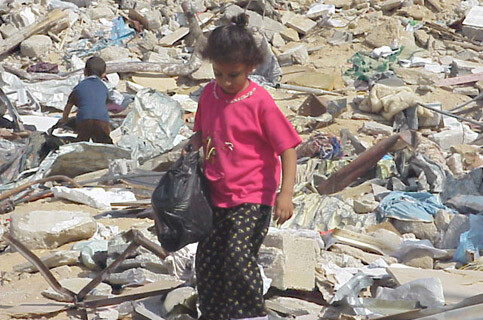World Bank 22 November 2004

The living standards of Palestinians have dramatically declined. Some 47 percent of Palestinians live below the poverty line. (PCHR)
WASHINGTON — Four years since the outbreak of the intifada in September 2000, the Palestinian economy continues to be mired in deep recession, according to a World Bank report released today.
The third in a series of reports that examine the impact of the socio-economic crisis in the West Bank and Gaza, Intifada, Closures and Palestinian Economic Crisis: An Assessment reveals that although the Palestinian economy recovered in 2003, this upturn is short-lived. The economy remains severely depressed compared with the pre-intifada period, with closures stifling economic activity and restricting the movement of people and goods.
“Closures are a key factor behind today’s economic crisis in the West Bank. They have fragmented Palestinian economic space, raised the cost of doing business and eliminated the predictability needed to conduct business,” says Nigel Roberts, World Bank Country Director for the West Bank and Gaza.
According to the report, the living standards of Palestinians have dramatically declined. Despite economic stabilization in 2003, some 47 percent of Palestinians live below the poverty line. A separate publication* produced jointly by the Palestinian Central Bureau of Statistics and the World Bank, focuses on the ‘poorest of the poor’, noting that as many as 600,000 Palestinians cannot afford to meet their basic needs in food, clothing and shelter to survive. Facing what is known as subsistence poverty, this group whose expenditures amount to less than $1.5 a day per person, has become increasingly vulnerable to economic shocks.
Intifada, Closures and Palestinian Economic Crisis: An Assessment points out that despite a modest and short-term increase in jobs in 2003, labor market indicators show an economy performing well below its potential. The unemployment rate stood at 25 percent in 2003, compared with 10 percent before the intifada. Young people in particular were hard hit - 37 percent were without jobs compared with 14 percent before the intifada.
International donors played a critical role in helping Palestinian society endure the economic shocks, says the report. In the 2001-2003 period, donors provided an average of $950 million per year, which helped sustain social service delivery and support the poor through food, cash support and job creation. Without these programs, the report estimates an additional 250,000 persons would have fallen under the subsistence poverty line - 35 percent above the current level. Nevertheless, the report points out that the quality and coverage of basic social services are severely under stress.
“Donors have more than doubled their disbursement of aid since the intifada, and this has in effect prevented a more drastic drop in living standards” says Roberts. “But these levels of assistance cannot be sustained indefinitely,” he adds, warning of possible donor fatigue in the future.
To revive the Palestinian economy, the report argues that a radical easing of internal closures is needed. The close link between closures and Palestinian economic health is illustrated by the fact that last year’s short-lived growth was accompanied by a brief easing of closure and violence.
However, easing of internal closures alone will not be enough to create jobs and fight poverty. Ending the Palestinian economic crisis will also depend on opening external borders, so the private sector can trade in international markets. At the same time, the report calls on the Palestinian Authority to revive its reform program and maintain fiscal discipline in order to create an investment friendly climate.
More Information
Related Links